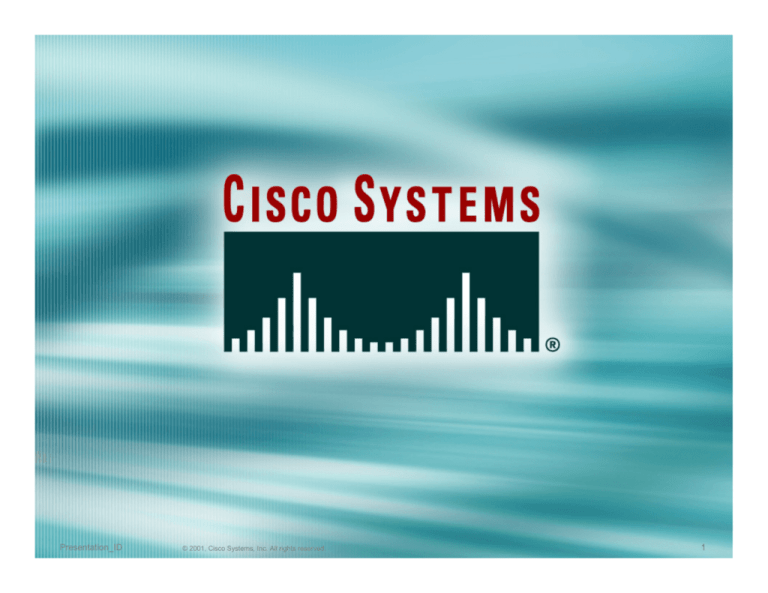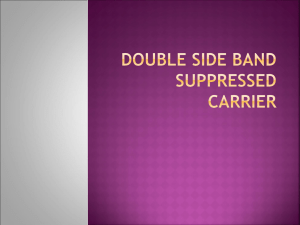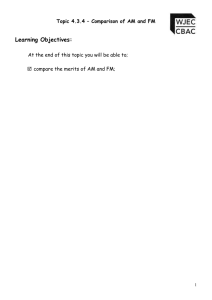
Presentation_ID
© 2001, Cisco Systems, Inc. All rights reserved.
1
QPSK and 16-QAM Digital
Modulation
Ron Hranac
Session Number
Presentation_ID
© 2001, Cisco Systems, Inc. All rights reserved.
2
Modulation
• Information such as sound (audio),
images (video), and digital data can be
transmitted from one point to another
using radio waves
• This is done by modulating an RF
signal—a carrier—with the information to
be transmitted
• Modulation is the variation one or more
properties of an RF signal to represent the
information being transmitted
Presentation_ID
© 2001, Cisco Systems, Inc. All rights reserved.
3
Modulation
• One or more of the following properties of
an RF signal may be varied to convey
information:
Amplitude—Amplitude of a carrier is varied.
This is called amplitude modulation (AM).
Frequency—Frequency of a carrier is varied.
This is called frequency modulation (FM).
Phase—Phase of a carrier is varied. This is
called phase modulation (PM).
Presentation_ID
© 2001, Cisco Systems, Inc. All rights reserved.
4
Modulation
Here are three examples of commonly used
modulation techniques, showing modulated
signals in the time domain. In these examples
the horizontal axis is time, and the vertical axis
is amplitude.
AM: amplitude modulation
Presentation_ID
FM: frequency modulation
© 2001, Cisco Systems, Inc. All rights reserved.
PM: phase modulation
5
Modulation
A radio receiver—TV set, AM or FM
radio, and even a cable modem or
CMTS—detects an RF signal’s
variations, and creates a nearly
identical copy of the original
modulating signal from those
variations.
Presentation_ID
© 2001, Cisco Systems, Inc. All rights reserved.
6
Basic Digital Modulation Formats
• FSK—Frequency shift keying: Information is
transmitted by shifting between two frequencies
to represent zeroes and ones
0
Presentation_ID
© 2001, Cisco Systems, Inc. All rights reserved.
1
7
Basic Digital Modulation Formats
• ASK—Amplitude shift keying: The amplitude of
a carrier is shifted between two states to
represent zeroes and ones
0
Presentation_ID
© 2001, Cisco Systems, Inc. All rights reserved.
1
8
Basic Digital Modulation Formats
• PSK—Phase shift keying: The phase of a carrier
is varied between two states to represent zeroes
and ones
If the phase shift between the two states is 180
degrees, the modulation is called BPSK, or biphase
shift keying
0
Presentation_ID
© 2001, Cisco Systems, Inc. All rights reserved.
1
9
More About Carrier Phase
• These graphics
represent RF carriers in
the time domain with
different phases relative
to one another. They all
have the same frequency
and the same amplitude.
•Assume that the top
carrier is assigned an
arbitrary phase value of 0°
•The second carrier’s
phase relative to the first
one is delayed 45°, the
third carrier is delayed
90°, the fourth carrier 135°
and so on
Presentation_ID
© 2001, Cisco Systems, Inc. All rights reserved.
0°
45°
90°
135°
180°
225°
270°
315°
10
I/Q Modulation
• Amplitude and phase can be modulated
simultaneously and separately to convey more
information than either method alone, but is
difficult to do
• An easier way is to separate the original signal
into a set of independent components or
channels: I (In-phase) and Q (Quadrature)
• The I and Q components are considered
orthogonal or in quadrature because they are
separated by 90 degrees
• The I and Q components are summed in a
modulator circuit
Presentation_ID
© 2001, Cisco Systems, Inc. All rights reserved.
11
I/Q Modulation
Polar display—Magnitude and
phase represented together
Presentation_ID
© 2001, Cisco Systems, Inc. All rights reserved.
“I-Q” format—Polar to
rectangular conversion
12
I/Q Modulator
• A single carrier generated by a
local oscillator (L.O.) circuit
is split into two paths
• One path is delayed by an
amount of time equal to ¼ of the
carrier’s cycle time, or 90 degrees
• The two carriers are amplitude
modulated—one by the I signal,
the other by the Q signal
• The two modulated carriers are
added together in a summing
circuit
• The output is a digitally
modulated signal whose amplitude
and phase are determined by the
amplitudes of the two modulating
signals
Presentation_ID
© 2001, Cisco Systems, Inc. All rights reserved.
Q
90° phase shift
Σ
L.O.
I
13
QPSK
• QPSK: quadrature phase shift keying
• Quadrature means the signal shifts among phase
states that are separated by 90 degrees
• The signal shifts in increments of 90 degrees from
45° to 135°, -45° (315°), or -135° (225°)
• Data into the modulator is separated into two
channels called I and Q
• Two bits are transmitted simultaneously, one per
channel
Presentation_ID
© 2001, Cisco Systems, Inc. All rights reserved.
14
QPSK
• Each channel modulates a carrier
The two carrier frequencies are the same, but their
phase is offset by 90 degrees (that is, they are “in
quadrature”)
• The two carriers are combined and transmitted
• Four states because 22 = 4
• Theoretical bandwidth efficiency is two
bits/second/Hz
Presentation_ID
© 2001, Cisco Systems, Inc. All rights reserved.
15
QPSK Symbol Mapping
Presentation_ID
© 2001, Cisco Systems, Inc. All rights reserved.
16
QPSK Constellation
Q
90°
135°
Symbol
Transmitted
Carrier
Phase
45°
Carrier
Amplitude
00
225°
1.0
01
135°
1.0
10
315°
1.0
11
45°
1.0
180°
0°
I
315°
225°
270°
Presentation_ID
© 2001, Cisco Systems, Inc. All rights reserved.
17
QPSK Constellation
Q
Symbol
Transmitted
Carrier
Phase
Carrier
Amplitude
00
225°
1.0
01
135°
1.0
10
315°
1.0
11
45°
1.0
I
Presentation_ID
© 2001, Cisco Systems, Inc. All rights reserved.
18
QPSK Constellation
Q
Symbol
Transmitted
Carrier
Phase
Carrier
Amplitude
00
225°
1.0
01
135°
1.0
10
315°
1.0
11
45°
1.0
I
Presentation_ID
© 2001, Cisco Systems, Inc. All rights reserved.
19
QPSK Constellation
Q
Symbol
Transmitted
Carrier
Phase
Carrier
Amplitude
00
225°
1.0
01
135°
1.0
10
315°
1.0
11
45°
1.0
I
Presentation_ID
© 2001, Cisco Systems, Inc. All rights reserved.
20
QPSK Constellation
Q
Symbol
Transmitted
Carrier
Phase
Carrier
Amplitude
00
225°
1.0
01
135°
1.0
10
315°
1.0
11
45°
1.0
I
Presentation_ID
© 2001, Cisco Systems, Inc. All rights reserved.
21
16-QAM
• 16-QAM: 16-state quadrature amplitude
modulation
• Four I values and four Q values are used,
yielding four bits per symbol
• 16 states because 24 = 16
• Theoretical bandwidth efficiency is four
bits/second/Hz
Presentation_ID
© 2001, Cisco Systems, Inc. All rights reserved.
22
16-QAM
• Data is spit into two channels, I and Q
• As with QPSK, each channel can take on two
phases. However, 16-QAM also accommodates
two intermediate amplitude values!
• Two bits are routed to each channel
simultaneously
• The two bits to each channel are added, then
applied to the respective channel’s modulator
Presentation_ID
© 2001, Cisco Systems, Inc. All rights reserved.
23
16-QAM Constellation
Q
Symbol
Transmitted
Carrier
Phase
Carrier
Amplitude
0000
225°
0.33
0001
255°
0.75
0010
195°
0.75
0011
225°
1.0
0100
135°
0.33
0101
105°
0.75
0110
165°
0.75
0111
135°
1.0
1000
315°
0.33
1001
285°
0.75
1010
345°
0.75
1011
315°
1.0
1100
45°
0.33
1101
75°
0.75
1110
15°
0.75
1111
45°
1.0
Presentation_ID
© 2001, Cisco Systems, Inc. All rights reserved.
90°
135°
45°
0°
180°
I
315°
225°
270°
24
16-QAM Constellation
Symbol
Transmitted
Carrier
Phase
Carrier
Amplitude
0000
225°
0.33
0001
255°
0.75
0010
195°
0.75
0011
225°
1.0
0100
135°
0.33
0101
105°
0.75
0110
165°
0.75
0111
135°
1.0
1000
315°
0.33
1001
285°
0.75
1010
345°
0.75
1011
315°
1.0
1100
45°
0.33
1101
75°
0.75
1110
15°
0.75
1111
45°
1.0
Presentation_ID
© 2001, Cisco Systems, Inc. All rights reserved.
Q
I
25
16-QAM Constellation
Symbol
Transmitted
Carrier
Phase
Carrier
Amplitude
0000
225°
0.33
0001
255°
0.75
0010
195°
0.75
0011
225°
1.0
0100
135°
0.33
0101
105°
0.75
0110
165°
0.75
0111
135°
1.0
1000
315°
0.33
1001
285°
0.75
1010
345°
0.75
1011
315°
1.0
1100
45°
0.33
1101
75°
0.75
1110
15°
0.75
1111
45°
1.0
Presentation_ID
© 2001, Cisco Systems, Inc. All rights reserved.
Q
I
26
16-QAM Constellation
Symbol
Transmitted
Carrier
Phase
Carrier
Amplitude
0000
225°
0.33
0001
255°
0.75
0010
195°
0.75
0011
225°
1.0
0100
135°
0.33
0101
105°
0.75
0110
165°
0.75
0111
135°
1.0
1000
315°
0.33
1001
285°
0.75
1010
345°
0.75
1011
315°
1.0
1100
45°
0.33
1101
75°
0.75
1110
15°
0.75
1111
45°
1.0
Presentation_ID
© 2001, Cisco Systems, Inc. All rights reserved.
Q
I
27
16-QAM Constellation
Symbol
Transmitted
Carrier
Phase
Carrier
Amplitude
0000
225°
0.33
0001
255°
0.75
0010
195°
0.75
0011
225°
1.0
0100
135°
0.33
0101
105°
0.75
0110
165°
0.75
0111
135°
1.0
1000
315°
0.33
1001
285°
0.75
1010
345°
0.75
1011
315°
1.0
1100
45°
0.33
1101
75°
0.75
1110
15°
0.75
1111
45°
1.0
Presentation_ID
© 2001, Cisco Systems, Inc. All rights reserved.
Q
I
28
16-QAM Constellation
Symbol
Transmitted
Carrier
Phase
Carrier
Amplitude
0000
225°
0.33
0001
255°
0.75
0010
195°
0.75
0011
225°
1.0
0100
135°
0.33
0101
105°
0.75
0110
165°
0.75
0111
135°
1.0
1000
315°
0.33
1001
285°
0.75
1010
345°
0.75
1011
315°
1.0
1100
45°
0.33
1101
75°
0.75
1110
15°
0.75
1111
45°
1.0
Presentation_ID
© 2001, Cisco Systems, Inc. All rights reserved.
Q
I
29
16-QAM Constellation
Symbol
Transmitted
Carrier
Phase
Carrier
Amplitude
0000
225°
0.33
0001
255°
0.75
0010
195°
0.75
0011
225°
1.0
0100
135°
0.33
0101
105°
0.75
0110
165°
0.75
0111
135°
1.0
1000
315°
0.33
1001
285°
0.75
1010
345°
0.75
1011
315°
1.0
1100
45°
0.33
1101
75°
0.75
1110
15°
0.75
1111
45°
1.0
Presentation_ID
© 2001, Cisco Systems, Inc. All rights reserved.
Q
I
30
16-QAM Constellation
Symbol
Transmitted
Carrier
Phase
Carrier
Amplitude
0000
225°
0.33
0001
255°
0.75
0010
195°
0.75
0011
225°
1.0
0100
135°
0.33
0101
105°
0.75
0110
165°
0.75
0111
135°
1.0
1000
315°
0.33
1001
285°
0.75
1010
345°
0.75
1011
315°
1.0
1100
45°
0.33
1101
75°
0.75
1110
15°
0.75
1111
45°
1.0
Presentation_ID
© 2001, Cisco Systems, Inc. All rights reserved.
Q
I
31
16-QAM Constellation
Symbol
Transmitted
Carrier
Phase
Carrier
Amplitude
0000
225°
0.33
0001
255°
0.75
0010
195°
0.75
0011
225°
1.0
0100
135°
0.33
0101
105°
0.75
0110
165°
0.75
0111
135°
1.0
1000
315°
0.33
1001
285°
0.75
1010
345°
0.75
1011
315°
1.0
1100
45°
0.33
1101
75°
0.75
1110
15°
0.75
1111
45°
1.0
Presentation_ID
© 2001, Cisco Systems, Inc. All rights reserved.
Q
I
32
16-QAM Constellation
Symbol
Transmitted
Carrier
Phase
Carrier
Amplitude
0000
225°
0.33
0001
255°
0.75
0010
195°
0.75
0011
225°
1.0
0100
135°
0.33
0101
105°
0.75
0110
165°
0.75
0111
135°
1.0
1000
315°
0.33
1001
285°
0.75
1010
345°
0.75
1011
315°
1.0
1100
45°
0.33
1101
75°
0.75
1110
15°
0.75
1111
45°
1.0
Presentation_ID
© 2001, Cisco Systems, Inc. All rights reserved.
Q
I
33
16-QAM Constellation
Symbol
Transmitted
Carrier
Phase
Carrier
Amplitude
0000
225°
0.33
0001
255°
0.75
0010
195°
0.75
0011
225°
1.0
0100
135°
0.33
0101
105°
0.75
0110
165°
0.75
0111
135°
1.0
1000
315°
0.33
1001
285°
0.75
1010
345°
0.75
1011
315°
1.0
1100
45°
0.33
1101
75°
0.75
1110
15°
0.75
1111
45°
1.0
Presentation_ID
© 2001, Cisco Systems, Inc. All rights reserved.
Q
I
34
16-QAM Constellation
Symbol
Transmitted
Carrier
Phase
Carrier
Amplitude
0000
225°
0.33
0001
255°
0.75
0010
195°
0.75
0011
225°
1.0
0100
135°
0.33
0101
105°
0.75
0110
165°
0.75
0111
135°
1.0
1000
315°
0.33
1001
285°
0.75
1010
345°
0.75
1011
315°
1.0
1100
45°
0.33
1101
75°
0.75
1110
15°
0.75
1111
45°
1.0
Presentation_ID
© 2001, Cisco Systems, Inc. All rights reserved.
Q
I
35
16-QAM Constellation
Symbol
Transmitted
Carrier
Phase
Carrier
Amplitude
0000
225°
0.33
0001
255°
0.75
0010
195°
0.75
0011
225°
1.0
0100
135°
0.33
0101
105°
0.75
0110
165°
0.75
0111
135°
1.0
1000
315°
0.33
1001
285°
0.75
1010
345°
0.75
1011
315°
1.0
1100
45°
0.33
1101
75°
0.75
1110
15°
0.75
1111
45°
1.0
Presentation_ID
© 2001, Cisco Systems, Inc. All rights reserved.
Q
I
36
16-QAM Constellation
Symbol
Transmitted
Carrier
Phase
Carrier
Amplitude
0000
225°
0.33
0001
255°
0.75
0010
195°
0.75
0011
225°
1.0
0100
135°
0.33
0101
105°
0.75
0110
165°
0.75
0111
135°
1.0
1000
315°
0.33
1001
285°
0.75
1010
345°
0.75
1011
315°
1.0
1100
45°
0.33
1101
75°
0.75
1110
15°
0.75
1111
45°
1.0
Presentation_ID
© 2001, Cisco Systems, Inc. All rights reserved.
Q
I
37
16-QAM Constellation
Symbol
Transmitted
Carrier
Phase
Carrier
Amplitude
0000
225°
0.33
0001
255°
0.75
0010
195°
0.75
0011
225°
1.0
0100
135°
0.33
0101
105°
0.75
0110
165°
0.75
0111
135°
1.0
1000
315°
0.33
1001
285°
0.75
1010
345°
0.75
1011
315°
1.0
1100
45°
0.33
1101
75°
0.75
1110
15°
0.75
1111
45°
1.0
Presentation_ID
© 2001, Cisco Systems, Inc. All rights reserved.
Q
I
38
16-QAM Constellation
Symbol
Transmitted
Carrier
Phase
Carrier
Amplitude
0000
225°
0.33
0001
255°
0.75
0010
195°
0.75
0011
225°
1.0
0100
135°
0.33
0101
105°
0.75
0110
165°
0.75
0111
135°
1.0
1000
315°
0.33
1001
285°
0.75
1010
345°
0.75
1011
315°
1.0
1100
45°
0.33
1101
75°
0.75
1110
15°
0.75
1111
45°
1.0
Presentation_ID
© 2001, Cisco Systems, Inc. All rights reserved.
Q
I
39
16-QAM Constellation
Symbol
Transmitted
Carrier
Phase
Carrier
Amplitude
0000
225°
0.33
0001
255°
0.75
0010
195°
0.75
0011
225°
1.0
0100
135°
0.33
0101
105°
0.75
0110
165°
0.75
0111
135°
1.0
1000
315°
0.33
1001
285°
0.75
1010
345°
0.75
1011
315°
1.0
1100
45°
0.33
1101
75°
0.75
1110
15°
0.75
1111
45°
1.0
Presentation_ID
© 2001, Cisco Systems, Inc. All rights reserved.
Q
I
40
16-QAM Constellation
Q
Peak symbol power
I
Presentation_ID
© 2001, Cisco Systems, Inc. All rights reserved.
41
16-QAM Symbol Mapping
Gray-Coded Symbol Mapping
Presentation_ID
© 2001, Cisco Systems, Inc. All rights reserved.
42
16-QAM Symbol Mapping
Differential-Coded Symbol Mapping
Presentation_ID
© 2001, Cisco Systems, Inc. All rights reserved.
43
QPSK and 16-QAM in the Upstream
Channel
bandwidth,
MHz
Symbol rate,
ksym/sec
QPSK raw
data rate,
Mbps
16-QAM raw
QPSK
nominal data data rate,
Mbps
rate, Mbps
16-QAM
nominal data
rate, Mbps
0.200
160
0.32
~0.3
0.64
~0.6
0.400
320
0.64
~0.6
1.28
~1.2
0.800
640
1.28
~1.2
2.56
~2.4
1.60
1,280
2.56
~2.3
5.12
~4.8
3.20
2,560
5.12
~4.6
10.24
~9.0
Presentation_ID
© 2001, Cisco Systems, Inc. All rights reserved.
44
Upstream C/N Ratio
• To achieve a 1x10-6 bit error rate (BER):
QPSK requires 13.81 dB carrier-to-noise ratio (C/N or
CNR)
16-QAM requires 20.92 dB C/N
These are theoretical values, and assume additive white
Gaussian noise (AWGN) is the only impairment
• Forward error correction (FEC) buys another ~2 dB
• In order to maintain the same BER obtained with
QPSK, the C/N must be ~7 dB better when 16-QAM is
used
• DOCSIS assumes a minimum 25 dB carrier-to-noise,
carrier-to-interference and carrier-to-ingress power
ratios in the upstream, regardless of modulation
format
Presentation_ID
© 2001, Cisco Systems, Inc. All rights reserved.
45
What About Impairments?
This is what is transmitted—the RF
signal’s instantaneous amplitude and
phase represent the symbol “11”
Q
I
Presentation_ID
© 2001, Cisco Systems, Inc. All rights reserved.
46
What About Impairments?
This is what is received after noise
randomly mixes with the transmitted
signal somewhere in the transmission
path. Because the received RF signal’s
phase and amplitude didn’t change very
much from what was actually
transmitted, the data receiver interprets
the signal as “11”.
Q
I
Presentation_ID
© 2001, Cisco Systems, Inc. All rights reserved.
47
What About Impairments?
The next time the symbol “11” is
transmitted, the RF signal randomly mixes
with noise again. But this time the
received signal’s amplitude is a little
lower, and the phase is shifted slightly.
The received phase and amplitude are still
close enough to the ideal position to be
interpreted by the data receiver as “11”.
Q
I
Presentation_ID
© 2001, Cisco Systems, Inc. All rights reserved.
48
What About Impairments?
Q
The same symbol transmitted
multiple times mixes randomly each
time with noise in the transmission
path. As a result, each received
symbol’s plotted position on the
constellation is slightly different. In
this example, all of the received
signals’ phases and amplitudes are
able to be interpreted as “11”.
Presentation_ID
© 2001, Cisco Systems, Inc. All rights reserved.
I
49
What About Impairments?
Q
Here a large burst of noise mixes
with the RF signal, causing the
received phase and amplitude to be
outside of the “decision boundary”
for the desired symbol. The data
receiver is not able to correctly
interpret the received signal as
“11”, so an error occurs.
Presentation_ID
© 2001, Cisco Systems, Inc. All rights reserved.
I
50
Modulation Error Ratio: Modulation Quality
Modulation error = Transmitted symbol – Target symbol
Q
Modulation error
Target symbol
Transmitted symbol
I
Source: Hewlett-Packard
Presentation_ID
© 2001, Cisco Systems, Inc. All rights reserved.
51
Modulation Error Ratio
MER = 10log(average symbol power/average error power)
Q
Average error power
Average symbol
power
I
Source: Hewlett-Packard
Presentation_ID
© 2001, Cisco Systems, Inc. All rights reserved.
52
Modulation Error Ratio
Q
Q
I
A large “cloud” of
symbol points means
low MER—this is not
good!
Presentation_ID
© 2001, Cisco Systems, Inc. All rights reserved.
I
A small “cloud” of
symbol points means
high MER—this is
good!
53
Modulation Error Ratio
• QPSK typically requires a minimum MER of 10~13
dB, depending on CMTS make/model
• Noise appears random
• CW produces “donut” shape
Ideal
Noise
CW Tone
Courtesy of Filtronic Sigtek, Inc.
Presentation_ID
© 2001, Cisco Systems, Inc. All rights reserved.
54
Modulation Error Ratio
• 16-QAM typically requires a minimum MER of 17~20
dB, depending on CMTS make/model
• Noise appears random
• CW produces “donut” shape
Ideal
Noise
CW Tone
Courtesy of Filtronic Sigtek, Inc.
Presentation_ID
© 2001, Cisco Systems, Inc. All rights reserved.
55
Presentation_ID
© 2001, Cisco Systems, Inc. All rights reserved.
56






